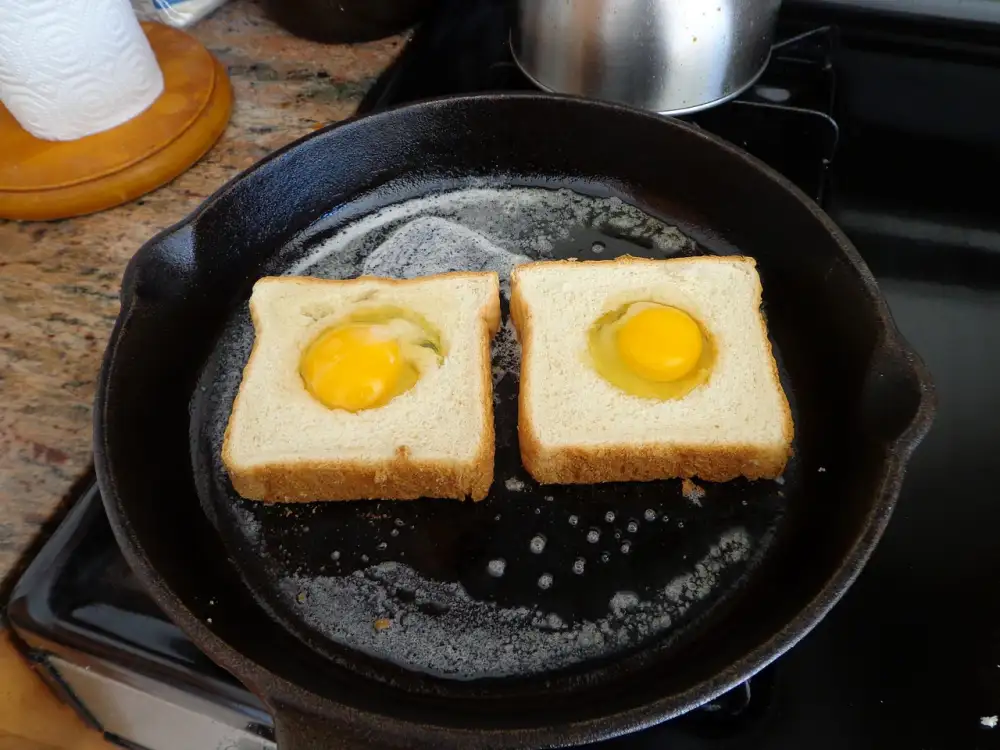Ultimate Guide to Cleaning a Cast Iron Skillet: Tips for a Spotless Kitchen Essential

- Gather necessary materials: coarse salt, sponge, dish soap, paper towels, and a soft cloth.
- Allow the skillet to cool down completely before cleaning.
- Sprinkle a generous amount of coarse salt on the skillet's surface.
- Use a damp sponge to scrub the salt in circular motions to remove food residue.
- Rinse the skillet under warm water, avoiding the use of soap at this stage.
- Dry the skillet thoroughly with paper towels.
- Place the skillet on a stove burner set to low heat to ensure complete drying.
- Once dry, apply a thin layer of oil to the skillet using a soft cloth to prevent rusting.
- Store the skillet in a dry place to maintain its seasoning.
Gather necessary materials: coarse salt, sponge, dish soap, paper towels, and a soft cloth.
To properly clean a cast iron skillet, it is essential to gather the necessary materials beforehand. You will need coarse salt, a sponge, dish soap (if needed), paper towels, and a soft cloth. These items will help you effectively remove food residue and maintain the skillet's seasoning for long-lasting use. Make sure to have these materials on hand before starting the cleaning process to ensure a spotless kitchen essential.
Allow the skillet to cool down completely before cleaning.
Before diving into the cleaning process, it's crucial to allow your cast iron skillet to cool down completely. This step is essential to prevent any accidental burns or injuries during the cleaning process. Cast iron retains heat very well, so even after cooking is done, the skillet can remain hot for a significant amount of time. Allowing it to cool down ensures a safe and effective cleaning experience while also protecting the skillet from any potential damage that could occur if cleaned while still hot.
Sprinkle a generous amount of coarse salt on the skillet's surface.
After allowing the cast iron skillet to cool down completely, the next step in cleaning is to sprinkle a generous amount of coarse salt on its surface. The coarse salt acts as an abrasive agent that helps to loosen and remove any stuck-on food particles without damaging the skillet's seasoning. The salt also helps to absorb any lingering grease or moisture, aiding in the cleaning process. By gently scrubbing the salt into the skillet's surface using a damp sponge and circular motions, you can effectively lift off any residue for a thorough clean.
Use a damp sponge to scrub the salt in circular motions to remove food residue.
After sprinkling a generous amount of coarse salt on the surface of your cast iron skillet, it's time to start scrubbing away the food residue. Take a damp sponge and begin scrubbing in circular motions. The abrasive texture of the salt combined with the gentle pressure from the sponge helps to lift off any stuck-on bits without damaging the skillet's seasoning. Be thorough but gentle to ensure a spotless finish without causing any scratches on the surface.
Rinse the skillet under warm water, avoiding the use of soap at this stage.
After scrubbing the skillet with salt to remove food residue, it's time to rinse it under warm water. Avoid using soap at this stage as it can strip away the skillet's seasoning. The warm water will help to wash away any remaining salt and food particles without compromising the skillet's seasoned surface. Make sure to thoroughly rinse off all the salt before moving on to the next step in cleaning your cast iron skillet.
Dry the skillet thoroughly with paper towels.
After rinsing the skillet under warm water, it is crucial to dry it thoroughly to prevent rusting. Use paper towels to wipe off any remaining moisture on the surface of the skillet. Make sure to reach all corners and edges to ensure complete drying. Any leftover water can lead to rust formation, which can damage the skillet over time. Once you have dried the skillet with paper towels, proceed to the next step of placing it on a stove burner set to low heat for further drying.
Place the skillet on a stove burner set to low heat to ensure complete drying.
After drying the skillet thoroughly with paper towels, it is essential to ensure complete drying to prevent rusting. To do this, place the skillet on a stove burner set to low heat. The gentle heat will help evaporate any remaining moisture from the surface of the skillet. Leave it on the burner for a few minutes until you are confident that it is completely dry. This step is crucial in maintaining the quality and longevity of your cast iron skillet.
Once dry, apply a thin layer of oil to the skillet using a soft cloth to prevent rusting.
Once the cast iron skillet is completely dry, it is essential to prevent rusting by applying a thin layer of oil. This helps to maintain the skillet's seasoning and protect it from moisture. Using a soft cloth, gently coat the entire surface of the skillet with a high smoke point oil such as vegetable oil or flaxseed oil. Make sure to cover both the inside and outside of the skillet evenly to create a protective barrier against oxidation. This simple step will ensure that your cast iron skillet remains in top condition for years to come.
Store the skillet in a dry place to maintain its seasoning.
To maintain the seasoning of your cast iron skillet, it is crucial to store it in a dry place. Moisture can lead to rust and deterioration of the skillet's seasoning. After cleaning and drying the skillet thoroughly, make sure to store it in a well-ventilated area away from any sources of moisture. Avoid stacking other items on top of the skillet as this can trap moisture and compromise its seasoning. By storing your cast iron skillet properly, you can ensure that it remains in optimal condition for years to come.
Published: 10. 03. 2024
Category: Food



